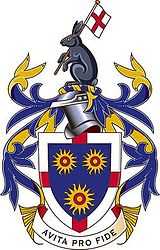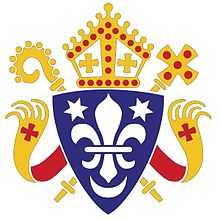St Edmund's College, Ware
 | |
| Motto |
Avita pro fide (Latin: For the faith of our fathers) |
|---|---|
| Established | 1568 |
| Type | Independent day and boarding |
| Religion | Roman Catholic |
| President | Most Rev Vincent Nichols, Archbishop of Westminster |
| Headmaster | Mr P Duran |
| Chair of the Board of Governors | Mr J M Gillham |
| Location |
Old Hall Green Ware Hertfordshire SG11 1DS England |
| Gender | Coeducational |
| Ages | 3–18 |
| Former pupils | Old Edmundians |
| Diocese | Westminster |
| Website | School website |
St Edmund's College is a coeducational independent day and boarding school in the British public school tradition set on 440 acres (1.8 km2) in Ware, Hertfordshire. Founded in 1568 as a seminary then boys' school, it is the oldest continuously operating and oldest post-Reformation Catholic school in the country. Today it caters to boys and girls aged 3 to 18.
History
Douay: 1568-1793
St. Edmund's College is a continuation on English soil of the English College that was founded by Cardinal William Allen at Douay in Flanders, France in 1568. Originally intended as a seminary to prepare priests to work in England to keep Catholicism alive, it soon also became a boys' school for Catholics, who were debarred from having such institutions in England. Many of its students, both priests and laymen, returned to England to be put to death under the anti-Catholic laws. The College includes amongst its former alumni 20 canonised and 133 beatified martyrs.
Silkstead, Twyford, Standon & Old Hall Green: 1662-1793
In the second half of the 17th century, a small Catholic school was begun in Hampshire. It was opened by a priest at Silkstead prior to 1662, and then transferred to Twyford, near Winchester. It was conducted in great secrecy, and was for boys of preparatory school age, intending to proceed to the English College to complete more advanced studies. The poet Alexander Pope was a student at this school, although he did not proceed to Douay. Twyford was closed in 1745 on account of anti-Catholic feeling caused by the Jacobite rebellion, but Bishop Richard Challoner re-established the school in Hertfordshire at Standon Lordship in 1749, in a property owned by the Aston family. In 1769, Bishop James Talbot moved the school to its current site at Old Hall Green, near Puckeridge, and it became known as Old Hall Green Academy.
Old Hall Green: 1793 - present
The work of the English College in Douay was brought to an end by the French Revolution. In October 1793 the College property was confiscated. Professors and students came back to England where, as a result of the Relief Acts, the penal laws against Catholics were considerably relaxed. John Douglass, Vicar Apostolic of the London District, realised that the time had come to replace the English College, and the earliest refugees joined the students at Old Hall Green Academy.
On 16 November 1793 - the feast of Saint Edmund, Archbishop of Canterbury - a new College was instituted.
The establishment of St Edmund's College was the beginning of the restoration of Catholic colleges and seminaries throughout England. The remaining staff and students arrived from Douay by 1795, not before students from the North had left and established a separate foundation which is now Ushaw College, near Durham. A gift of £10,000 from John Sone, a Hampshire Catholic, enabled St. Edmund's to be established in new buildings designed by James Taylor of Islington, who had himself been a student at the Old Hall Green Academy.
The fortunes of the College varied throughout the 19th century, and at times it seemed as if the school might have to close. However, in 1853 a large Gothic chapel designed by Augustus Welby Pugin was completed. This project was begun during the episcopate of Bishop Thomas Griffiths, who had been the College's President from 1818 until 1834, and had done much to give the College a sound financial basis.
The era of Vicars Apostolic ended in 1850 with the restoration of the Hierarchy. In 1869, the Archbishop of Westminster, Henry Edward Manning, set up a seminary in Hammersmith, and for the first time St Edmund's ceased to be a theological college. In 1874, the junior boys were separated from the rest of the College into St Hugh's Preparatory School, in a house originally built by Pugin for the Oxford convert W. G. Ward. The prep school has since been renamed St Edmund's Preparatory School.
In 1893 his son, Bernard Ward, was appointed President, and he started a scheme of rebuilding and improvements. Numbers in the school increased significantly, and in 1904 Archbishop Francis Bourne decided to return the seminarians to the College. A new wing was built to house them, and this part of the College eventually became known as Allen Hall, after Cardinal Allen, the founder of the English College at Douay.
The College became considerably run down during the First World War. However, a legacy of money became available to Cardinal Bourne, and this was used to carry out badly needed repairs and new additions.
The College celebrated the quatercentenary (i.e. the 400th anniversary) of its foundation in 1968. 1975 saw the departure of the seminarians for the second time: they moved to Chelsea but retained the name of Allen Hall. The school expanded considerably during the 1970s. In 1974, girls from the nearby Poles Convent and elsewhere were admitted into the sixth form as the first step towards complete coeducation, which was accomplished with the closure of Poles Convent in 1986. In 1996, an infants department was added to the junior school, meaning St Edmund's now educates pupils from age 3 to 18.
Houses
Heads of House, assisted by a team of Tutors, provide the continuity of care throughout a student's time at the College and they are the normal means of contact between College and parents. House spirit is encouraged through a variety of Inter-House competitions, both sporting and cultural, and through numerous House celebrations, ranging from formal dinners to summer barbecues.
There are five houses (year of foundation in brackets):
There are five former houses (years of existence in brackets):
- Allen Hall (1922-1975)
- Griffiths (1972-1984)
- Junior House (1945-1953 & 1961-1993)
- Margaret Pole (1975-1990)
- Stapleton (1975-1996)
Boarding
Pupils who choose to board have the option to board full-time or during certain days of the week. There are two main boarding houses: Allen Hall (boys) and Garvey's (girls). The accommodation areas are supervised by residential staff who are responsible for the welfare of the children and there are bathroom facilities on each floor.
O Beate mi Edmunde
The College anthem was composed by Cardinal Nicholas Wiseman for the solemn enshrinement of the Relic of St Edmund in the College Chapel. The song has a total of 30 verses arranged into three decades, the first and third decades are each preceded and concluded with the following chorus, and the second decade with a variation of it. It is sung every year on the 3 days before November 16, St Edmund's Day, when St Edmund is remembered. Ten verses are sung each day in chapel of what is called the Triduum.
- O Beate mi Edmunde,
- O Beate mi Edmunde,
- Sic pro me ad Filium Dei,
- Cum Maria preces funde,
- Cum Maria preces funde,
- Ut per vos sim placens Ei.
The Edmundian Association
The Edmundian Association was founded in 1853 and has members throughout the world. Its aim is to maintain a bond between the College and its alumni, and among members. Membership is available to past pupils of the College and their parents, parents of current pupils, and current and past members of staff.
Notable former pupils
Laymen
- Francis Barraud - Painter of Nipper, the HMV dog
- Sir Alan Burns - Diplomat
- Michel Jean Cazabon - Artist
- Siobhan Daly - Producer and Artistic Director
- HRH Princess Sikhanyiso Dlamini - Princess of Swaziland
- Simon Geoghegan - Irish International Rugby Player
- Adrian Gilbert - Bestselling author & publisher
- Everard Green - Rouge Dragon Pursuivant & Somerset Herald, College of Arms
- Sir Edward Henry Bt - Pioneer of fingerprints
- Tommie Hoban - Professional Footballer
- Javier Iturriaga - Professional Footballer
- James Lamont - BAFTA-winning comedy writer
- James Lynam Molloy - Poet
- Nick Nieland - Commonwealth Games Javelin Gold-Medallist
- Joseph O'Sullivan - Irish Nationalist
- Henry Oxenham - Controversialist & poet
- Ensign Everard Phillipps VC - Hero of the Indian Mutiny
- William Scholl - Footwear designer & businessman
- Captain Neville Stack - test pilot, air racer and aviation pioneer
- Aiden Turner - Actor
- Paul Alexander Zino - Ornithologist after whom Zino's Petrel is named
Clergy
- Cardinal Francis Bourne - Archbishop of Westminster (also buried here)
- Revd Adrian Fortescue - Priest, scholar & adventurer
- Canon Reginald C. Fuller - Scripture scholar
- Dr Bruce Kent - Laicised former Roman Catholic priest and Anti-War campaigner
- Bishop David Konstant - 8th Bishop of Leeds
- Monsignor Ronald Knox - Satirist, essayist, novelist & translator
- Bishop Declan Lang - Bishop of Clifton
- Bishop George Michael Lenihan OSB (1858-1910) - fifth Catholic Bishop of Auckland, New Zealand (1896-1910).
- Canon Frederick Oakeley - Translator of Adeste Fideles into English
- Monsignor Canon Clement Henry Parsons - Founder and First Headmaster of Finchley Catholic High School
- Archbishop George Stack - Archbishop of Cardiff
- Cardinal Herbert Vaughan - Archbishop of Westminster
- Archbishop Derek Worlock, CH - Archbishop of Liverpool
Monsignor Daniel Gilbert, D D Canon and Vicar General Diocese of Westminster 1868-1895 Founder of "Providence Row Night Refuge" R. C. Diocese of Westminster
References
- David J S Kay, The Buildings of St Edmund's College (St Edmund's College: 2000) ISBN 978-0-9538316-0-9
- David J S Kay, The People of St Edmund's College (The Edmundian Association: 2003) ISBN 978-0-9546125-0-4
- David J S Kay, St Edmund's College Prayer Book (illustrated by Joseph Pike) (The Edmundian Association: 2006) ISBN 978-0-9546125-1-1
- Fr Michael G Garvey, St Edmund's College and its Chapel - Historical Guide (The Edmundian Association: 2010) ISBN 978-0-9546125-2-8
- Nicholas Schofield, The History of St Edmund's College (picture editor David J S Kay) (The Edmundian Association: 2013) ISBN 978-0-9546125-3-5
External links
- College website
- The Edmundian Association
- Profile on the ISC website
 "Old Hall (St. Edmund's College)". Catholic Encyclopedia. New York: Robert Appleton Company. 1913.
"Old Hall (St. Edmund's College)". Catholic Encyclopedia. New York: Robert Appleton Company. 1913.
| ||||||||||||||||||||||||||||||||||||||||||||||||||||||||||||||||||||||||||||||||||||||||||||||||||||||||||||||||||||||||||||||||||||||||||
| ||||||||||||
